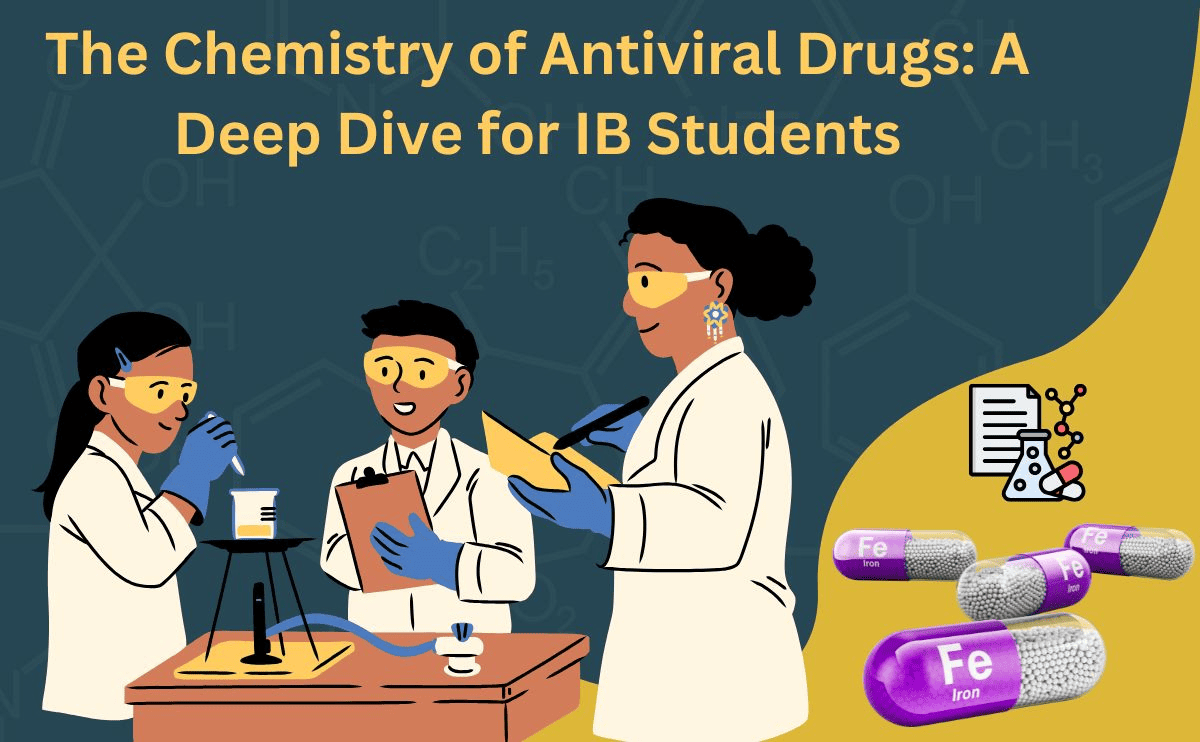OUR BLOG
The Chemistry of Antiviral Drugs: A Deep Dive for IB Students
Understanding the chemistry of antiviral drugs is essential for IB students, and having an experienced IB Tutor can help simplify complex biochemical concepts. The chemistry of antiviral drugs is much more than just an area of medicinal chemistry and pharmaceutical chemistry; it is an area of challenging research. These drugs are meant to fight viruses, disrupt their methods of reproduction, or enhance the functioning of the immune system. To the IB Chemistry students, such a presentation of the drugs’ mechanism of action is a perfect opportunity for the teacher to explain how the material studied in class is used in practice, for instance, in virus treatment and in the development of antiviral medications. With the flexibility of an IB Online Tutor, students can receive personalized guidance on key topics like molecular interactions and drug mechanisms.
Antiviral Drug Development: From the Laboratory to Life-Saving Therapies
The process of an antiviral drug starts from antiviral drug development, which is a field that combines pharmaceutical chemistry and drug design. Scientists identify which enzymes or proteins are important for the virus and, using medicinal chemistry, they design compounds that will block these targets. A classic example is the evolution of reverse transcriptase inhibitors for HIV treatment; these substances hinder the enzyme the virus requires to replicate itself.
To IB students learning about reaction mechanisms, equilibrium, and intermolecular forces, knowledge of the chemistry of antiviral drugs comes in handy. For example, the interaction of drugs with viral proteins often involves hydrogen bonding and van der Waals forces, which are topics in IB Chemistry.
Mechanism of Action: How Antiviral Drugs Work
In this category, antiviral drugs work by disrupting the virus's ability to enter and reproduce within host cells. These mechanisms include:
● Inhibition of Viral Entry: Drugs like fusion inhibitors stop the virus from penetrating an infected host cell. This includes the E2 viral envelope protein, which is related to lipid chemistry.
● Inhibition of Viral Replication: Nucleotide analogs resemble DNA or RNA and, when incorporated into the growing chain, they act like a pause button. This mechanism highlights the value of organic chemistry, especially nucleophilic substitution, in constructing these drugs.
● Inhibition of Viral Proteins: Protease inhibitors stop the virus from breaking down proteins that are vital to its existence, making the subject of enzyme kinetics coherent with IB Chemistry topics.
These examples illustrate the impact of the chemistry of antiviral drugs on theoretical chemistry and its importance for students.
Medicinal Chemistry: Designing Effective Antivirals
Optimization of the properties of drug molecules is one of the goals of medicinal chemistry, including solubility, stability, and selectivity. Chemists alter molecular structures to increase a drug’s efficacy and reduce its toxicity. For example, appending functional groups to a drug molecule can enhance its affinity to viral targets or improve its solubility.
From IB Chemistry topics such as functional groups, molecular geometry, and stereochemistry, students can relate to the principles when practicing pharmaceutical chemistry. These theoretical and practical connections help prepare them for further discussions on virus treatment and antiviral drugs. Additionally, a strong grasp of mathematical concepts is crucial for data analysis in Chemistry, making support from an IB Maths Tutor invaluable for mastering calculations and quantitative problem-solving.
IB Chemistry Online Tutor: Bridging the Gap
Any student interested in mastering the chemistry of antiviral drugs can consult an IB chemistry online tutor. Tutors can explain concepts like the mechanism of action and drug design in ways that make them easier for students to grasp.
Other benefits students derive from engaging an IB chemistry online tutor include opportunities to work through topics such as equilibrium in drug binding, reaction rates in drug metabolism, and spectroscopy for identifying drug compounds. Such an approach helps students relate acquired theory to practice, essential for excelling in IB Chemistry.
Conclusion: The RoadMap to Becoming an Expert in Antiviral Drugs
The chemistry of antiviral drugs is not just an academic subject but a gateway to understanding how science transforms global health. It is fascinating to see how all the subtleties of antiviral drug development and their exact mechanism of action fit into the framework of the IB Chemistry curriculum and its applications. By analyzing the chemistry of antiviral drugs, students can understand how medicinal chemistry and pharmaceutical chemistry play crucial roles in creating effective virus treatments.
If you would like to learn more about the chemistry of antiviral drugs and other challenging subjects, explore Baccalaureate Classes , offering expert tutoring services. Their IB chemistry online tutor services aim to ensure students excel in complex topics while linking theoretical knowledge to practical applications. Unlock your potential and get expert help with concepts of drug design from qualified tutors.

